Native Development vs Cross-Platform Development: Myth and Reality
In 2022 and 2023, mobile applications became even more important for businesses, as demand for online services went through the roof. Many businesses are looking for ways to develop mobile apps fast and on a budget, which has them considering cross-platform mobile development. Is it reliable and beneficial? Find out in this article
The current state of the mobile market
According to Statista, in 2020, people downloaded 218 billion apps. Just a year earlier, this number was 204 billion. Due to the pandemic, many businesses lost their opportunity to offer services offline and felt a need to offer services and products online to survive.
After the pandemic began, people were also more open to shifting many of their daily tasks online, such as grocery shopping, communicating, and working. In response, businesses that had little or no online presence started looking for ways to quickly build mobile apps.
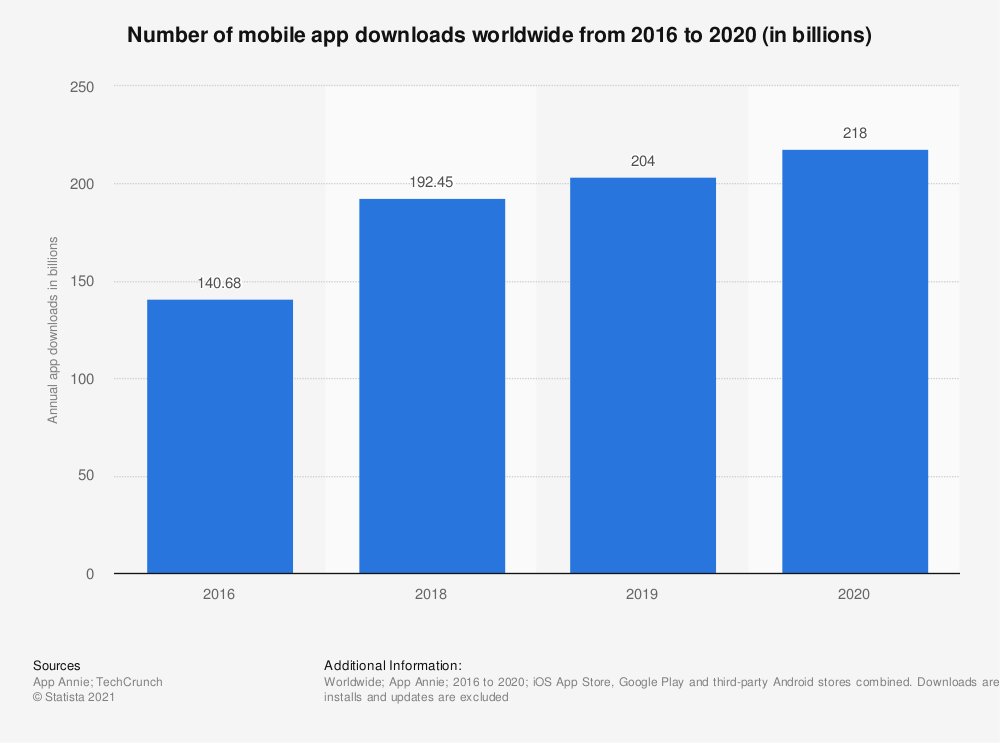
At the same time, the pandemic caused new market trends, and startups began to capitalize on them — in particular, by responding to a growing preference for mobile apps. According to Statista, worldwide mobile app revenue reached $461 billion in 2019, and by 2023, this number is expected to grow to almost a trillion dollars.
According to eMarketer, almost 90% of mobile time is spent in mobile apps compared to mobile browsers. For businesses, this means that having a mobile-friendly website is no longer enough to satisfy most mobile users.
Naturally, the number of mobile apps is growing exponentially, and for many businesses, time to market and the user experience have become more important success factors.
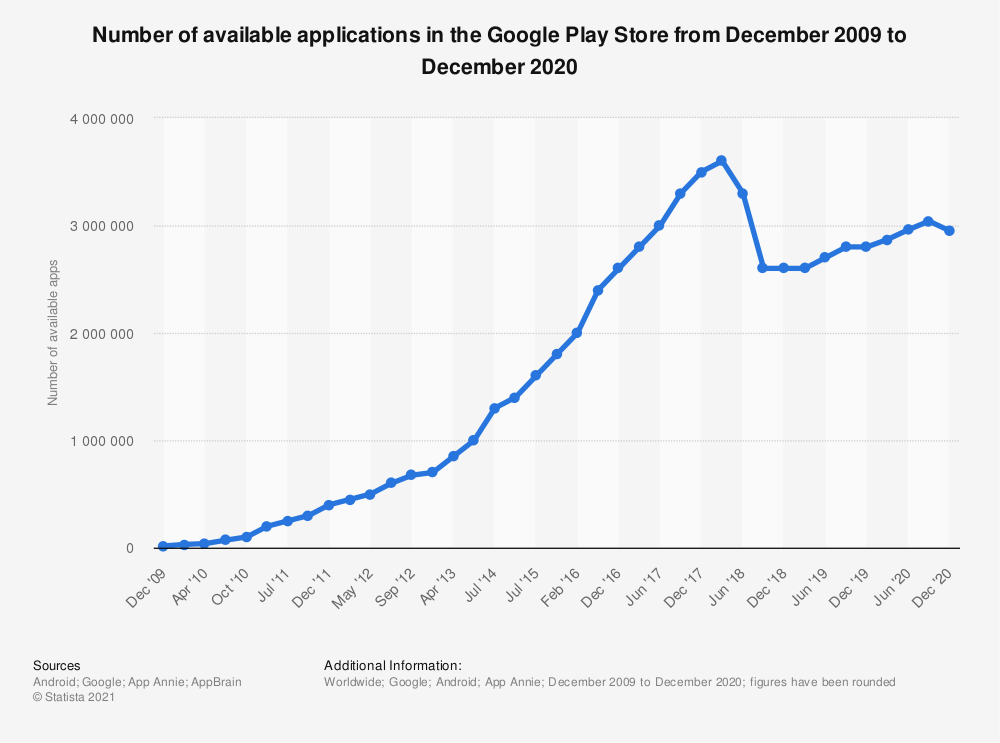
Business owners need a fast but reliable way to build mobile apps since the performance and quality of mobile applications are crucial, especially for user retention. Because the competition is so great, users have very little tolerance for low-quality apps. So what options do you have when it comes to mobile app development?
Top five ways to develop an app
Your development approach will influence lots of important factors such as:
- Your app’s cost
- Development time
- Team size
- Features you can implement
- Your app’s quality
- Customization opportunities
As you can see, choosing a development approach is one of the most important decisions you need to make before you start building your app. In this article, I’ll mostly be comparing two approaches: native and cross-platform development. But I want to briefly mention all of the possibilities.
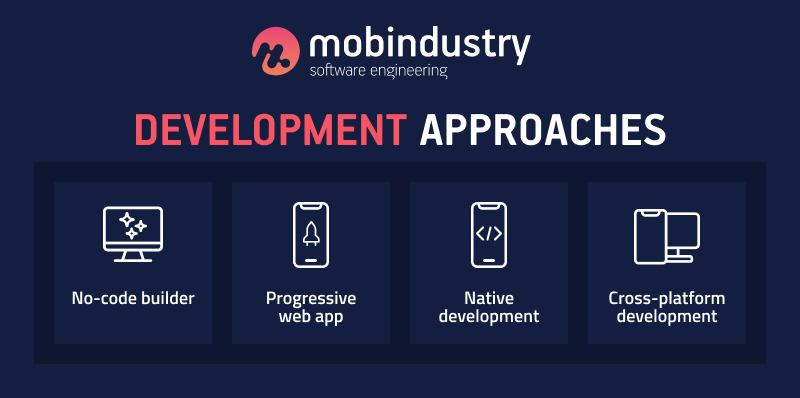
1. No-code builder
There are lots of no-code builders for websites and mobile apps that offer an intuitive and simple way to build a software product on your own. All you need to do is choose a theme, customize it a bit, and fill it with content. You’ll likely pay a monthly subscription for such a service, and in the long run, it might get costly.

I would recommend no-code builders for small local businesses that aren’t sure if they need a mobile app at all. No-code builders are very limited in terms of customization and functionality, so you won’t be able to create a high-quality app with a great UX and tons of features.
2. Progressive web app
A progressive web app (PWA) is another cheap option that’s basically a mobile website that mimics a native app. It can send push notifications and offers limited offline functionality but has little access to smartphone capabilities. A PWA also has lots of downsides such as relatively high battery consumption and no presence on app markets.
Moreover, PWAs are size limited, so you can only implement something simple with this technology. Functionality for user retention, such as loyalty programs, won’t work in a PWA.
I’d recommend a PWA for products that are high in content and already have large audiences they can promote the PWA. PWAs are a great start for popular web businesses.
3. Native development
Now it’s time to discuss mobile app development options that offer more opportunities for businesses. Native mobile app development is considered to be the highest quality, leading to functional and reliable applications for Android and iOS.
Apple and Google, the creators of the two most popular mobile platforms in the world that control over 99% of the global mobile market, each have their own native technology for app development. Google’s native programming languages are Kotlin and Java, and Apple’s are Swift and Objective-C.
These technologies are very different, just like the platforms themselves in terms of everything from their UI/UX principles to architectural patterns. That’s why if you want your app to be present on both platforms, you’ll need to develop two separate apps with the help of native mobile app developers.
Price is by far the biggest downside of native mobile app development compared to cross-platform development, which I’ll talk about next. However, the high quality and no friction when implementing features of any complexity are the benefits of native app development.
4. Cross-platform development
What is cross-platform application development? Cross-platform development uses another category of technologies that allows developers to create one app for two platforms simultaneously. There are lots of different cross-platform technologies, and you can choose any of them for your project. Today, the most popular are React Native and Flutter.
Cross-platform development allows businesses to save significant amounts of money because cross-platform apps work on both Android and iOS and need little modification for each platform. This is one of the biggest advantages of cross-platform apps. However, cross-platform development is also still covered in myths, both negative and positive. The goal of this article is to debunk or confirm them and help you choose between cross-platform and native application development.
Cross-platform vs native app development: main differences
1. Platform orientation
There are lots of differences between native and cross-platform app development, but one core difference is the platform orientation. While native technologies are dedicated to only a particular platform, cross-platform apps work equally well on more than one platform. This is the main reason many businesses choose a cross-platform development approach.
Want your app on both iOS and Android? With native development, you’ll have to develop it from scratch for each platform. This may sound extremely time-consuming, but native apps have the wonderful ability to use all of a smartphone’s services and functions.
2. Technologies
Native applications use an operating system’s native language. For Android, that’s mostly Kotlin, which is a newer programming language. Another older option is Java. The iOS operating system also has two languages: Swift, which is modern and relatively new, and Objective-C, which is already considered obsolete but that some native mobile app developers still use.
Cross-platform applications use completely different technologies. Depending on the framework, they can use HTML, CSS, and JavaScript and wrap it in a WebView, which is a browser inside a mobile app that renders the contents of a website. Another approach is to create a unified API on top of a native SDK, use native IDEs, and build an app that has a shared codebase for both Android and iOS.
3. Development freedom
Native SDKs and API tools allow developers to implement all functionality that’s available on the mobile development market. This means they can use the latest AR technologies in their apps and get full access to a device’s services and functions. All mobile hardware such as geolocation systems, cameras, and accelerometers will work flawlessly as a full-fledged part of the platform.
Cross-platform development is deemed to be of lower quality than native development because of its performance issues and difficulties in accessing native functionality. Frameworks like Xamarin, Ionic, and Cordova work like wrappers and have limited access to native functionality.
More modern cross-platform frameworks like Flutter and React Native have fewer issues with this and can provide programmers with development freedom close to that of a native app.
4. UI/UX quality
Native frameworks have their own tools for UI and UX design. Google has Material Design guidelines, while Apple offers Human Interface Guidelines. These guidelines help developers achieve a unified look and feel across native apps so that users know intuitively what each button does and how the app works, even if they’re opening it for the first time.
Native design guidelines help developers achieve a unified look and feel across native apps
Cross-platform apps may have issues with the UI and UX, as developers don’t have any native tools. They need to know the native design guidelines and follow them in their apps to get to a native app level of quality.
However, modern frameworks like React Native and Flutter have advanced documentation and guidelines that help developers create great apps. We’ll talk more about the best cross-platform technologies later in the article.
Now that we’ve made a native vs cross-platform mobile app development comparison, let’s discuss the two most popular and advanced cross-platform development technologies.
Top two cross-platform development technologies
Over the years, lots of cross-platform development technologies have appeared. The oldest included Xamarin, Ionic, and Unity, but newer cross-platform technologies have almost completely replaced them.
Today, the two most popular and reliable technologies for cross-platform development are Flutter and React Native. In this article, I’ll mainly talk about them, as they provide the highest quality and most reliable products.
React Native and Flutter are also the most popular modern cross-platform frameworks on the market, according to Statista.
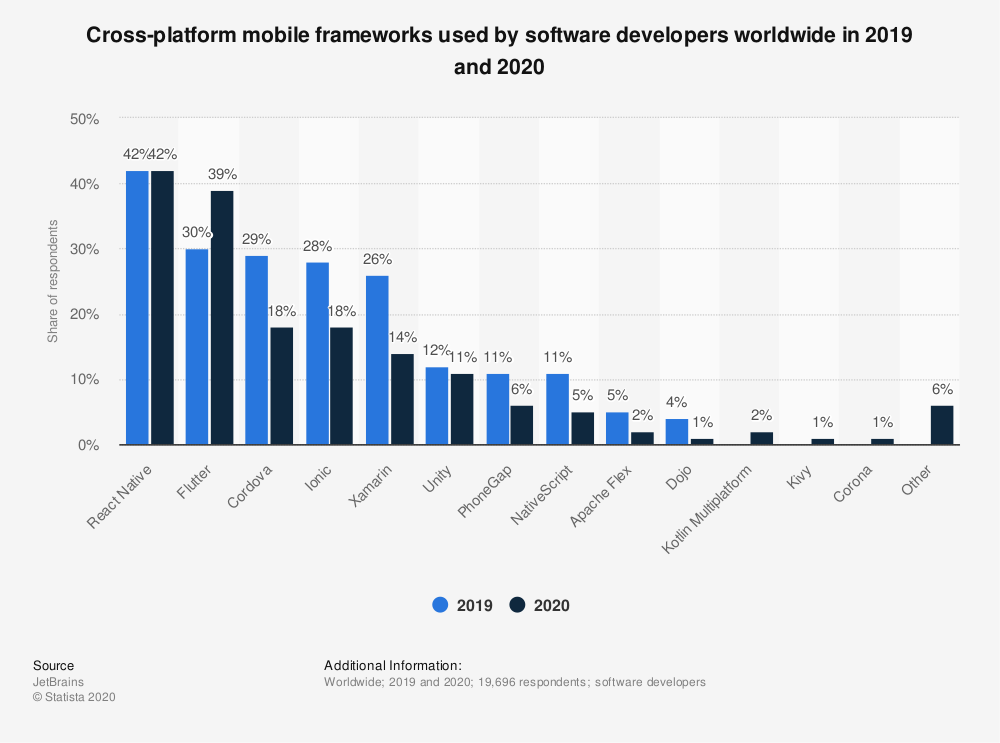
This is not a surprise, as both React Native and Flutter have large development communities, great documentation, and giant tech companies behind them. Let’s talk about these two technologies in more detail.
React Native
React Native is an open-source cross-platform development framework that was created and released by Facebook in 2015. It quickly became the best technology for cross platform mobile development on the market.
React Native uses web technologies including HTML, CSS, and JavaScript and communicates with native components like Images, Text, and View using platform-specific APIs and modules. React Native allows developers to build blocks that can be reused across an app. This makes development in React Native convenient and fast.
React Native can use most device hardware and native capabilities, but sometimes it’s hard to customize this functionality.
Flutter
Flutter is a younger technology that’s developed by Google. In the future, Google is planning to make Flutter its main native framework that will replace Android, so Flutter has lots of potential and is currently growing much faster than React Native. Its documentation is flawless and allows developers to pick up this technology really fast.
Flutter uses the Dart language, whose structure and logic are very similar to that of native languages, making it really easy to pick up for native Android and iOS developers. Flutter works through widgets, and this allows developers to reuse the same components across an app.
The best thing about Flutter is its performance, which is the same as with native languages. At Mobindustry, we have conducted a productivity test for both React Native and Flutter and compared them to native languages. We found Flutter to be just as good as Swift or Kotlin.
Other cross-platform frameworks include:
- Xamarin
- Apache Cordova
- Ionic
- Unity
I’d still recommend either Flutter or React Native for commercial products because their quality is close to that of native apps. They also offer many benefits and greater reliability compared to other cross-platform frameworks.
Cross-platform vs native apps: pros and cons
Let’s sum up the pros and cons of both mobile development approaches.
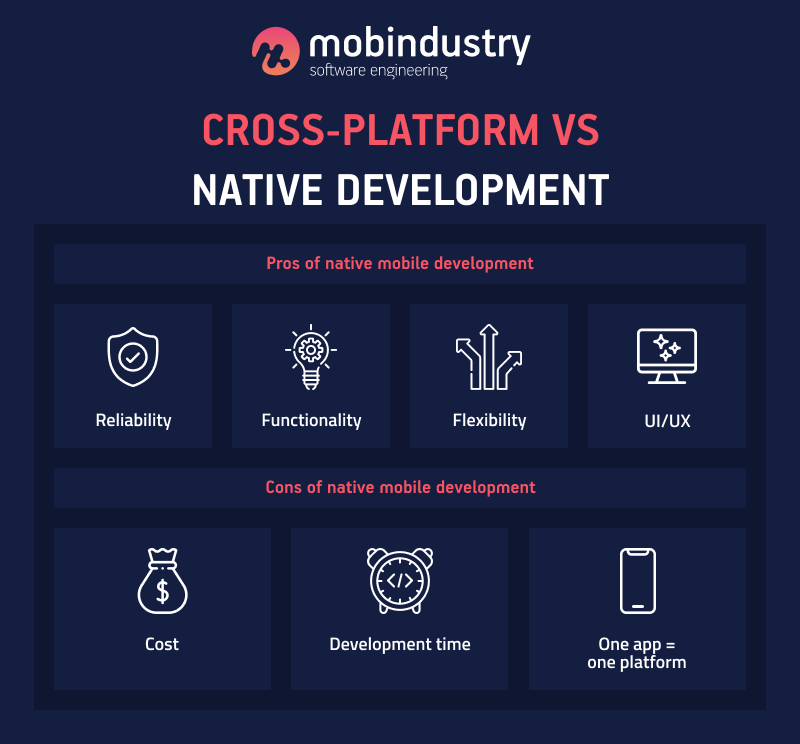
Pros of native mobile app development:
- Reliability
- Security
- Full functionality
- Development flexibility
- UI/UX guidelines and tools
Cons of native mobile app development:
- High cost
- Lengthy development time
- One app works only on one platform
Pros of cross-platform development:
- Lower cost
- Shorter development time
- One app will work on both Android and iOS
Cons of cross-platform development:
- Your app may be slower (especially with React Native)
- Not all functionality may be available
- Difficulties with UI and UX (rare with Flutter or React Native)
Now that we’ve discussed the advantages and disadvantages of cross platform mobile development and native app development, it should be easier for you to make a choice. However, there are lots of different factors that can also influence the decision. Let’s review them.
Key factors in choosing between native and cross-platform development
Let’s discuss exactly what you need to consider when choosing between these two development approaches. Remember that each situation is unique, and I always recommend consulting with developers, business analysts, and other IT specialists who can help you choose the best tech stack depending on your goals, business complexity, deadline, and budget.
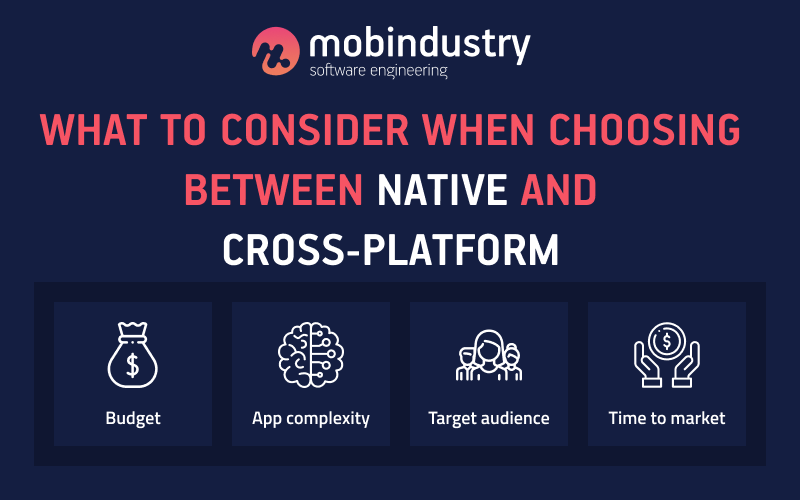
However, this article should help you learn more about your options. Here are the factors you need to consider before making a decision.
1. Your budget
App development isn’t cheap, and many businesses are looking for ways to save money on it without losing quality. Your budget and target platforms are the two most important factors to consider when choosing between native and cross-platform development.
React Native or Flutter can help you save up to 40% of the budget you’d spend on a native app for each platform.
2. Your target audience
There’s another way to save money: sacrifice one platform and build a native application only for Android or iOS. If your audience predominantly uses one platform, this can be an option for you.
For example, Clubhouse is currently available only on iOS. They created a high-quality app for one platform and decided to build an app for Android only when their iOS app had massive success.
Consider your audience when you choose a development approach: you can always build a native app and then create another app using revenue from the first app or money from investors.
3. Your time to market
If you want a native application for each platform, it will naturally take more time. Usually, iOS and Android apps are developed simultaneously, but this means you’ll need two teams of developers, meaning twice the budget.
Cross-platform apps allow you to get one app for both platforms at once, and if you need to build your MVP fast and conquer the market, this is the best option for you.
4. Your app’s complexity
Native apps can be as simple or as complex as you need, while cross-platform frameworks still have some restrictions. If your app has complex business logic or many animations, it’s best to choose native mobile development.
Native programming languages are extremely well-performing (though Flutter is too), and native apps are more reliable and secure. So if you plan to launch a complex application, it’s best to invest in native app development.
Cross-platform technologies are best for apps of up to middling complexity
Cross-platform technologies are best for apps of up to middling complexity. However, Flutter is constantly evolving, and Google already creates many of its products on Flutter, so you can count on this technology for more complex apps as well.
Final summary: what approach should you choose?
Just a few years ago, cross-platform apps were deemed low-quality and unreliable. Any integration and any attempt to access native functionality was a nightmare and required lots of tweaks. But this has changed. With React Native and Flutter, you can get cross-platform apps whose quality is very close to that of native apps.
That’s why more and more businesses are choosing these technologies for their commercial products. However, there is still strong demand for native, time-proven technologies. Let’s sum up everything I mentioned in this article to help you choose which approach will work best for you.
You should choose native development if:
- Your app needs access to all phone resources, services, and hardware
- Responsiveness and performance are your priority
- You need strong offline functionality
- You’re building a long-term app and plan to add more features to it
Consider cross-platform development if:
- You want to save money on development but still get an app for both platforms
- Your app doesn’t have overly complex business logic and animations
- Time to market is your priority
As you can see, with modern technology, you have little to sacrifice when it comes to cross-platform development. At Mobindustry, we developed native apps exclusively for many years. But once cross-platform technologies evolved, we started to offer them to our clients as worthy options.
If you have any questions on native app development or cross-platform development, don’t hesitate to contact us. Our specialists will help you choose the best tech stack for your specific needs.


